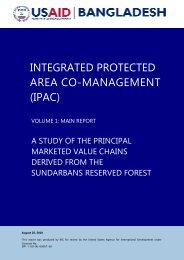Child Equity Atlas - BIDS
Child Equity Atlas - BIDS
Child Equity Atlas - BIDS
You also want an ePaper? Increase the reach of your titles
YUMPU automatically turns print PDFs into web optimized ePapers that Google loves.
Housing, Access to Sanitary Toilet and Electricity<br />
Housing, Access to Sanitary Toilet and Electricity<br />
5.0.0 Decent housing is an important indicator<br />
of people’s standard of living conditions in any<br />
country or geographic area with a strong bearing<br />
on their health, feeling of safety and stable state<br />
of mind. Decent housing was recognized as part<br />
of the right to an adequate standard of living in<br />
the 1948 Universal Declaration of Human Rights.<br />
It also goes a long way in providing safety and<br />
security to household members while protecting<br />
them from hazards, particularly children whose<br />
vulnerabilities increase without decent housing.<br />
5.0.1 Acknowledging the importance of decent<br />
accommodation, housing was incorporated in<br />
the constitution of Bangladesh as one of the<br />
five basic needs. Therefore, the Government<br />
is constitutionally responsible in securing the<br />
housing rights of its citizen, particularly for the<br />
disadvantaged and marginalized. Housing for the<br />
disadvantaged is not only an absolute necessity<br />
for survival but it also provides them with a<br />
productive asset.<br />
5.0.2 Access to a sanitary toilet is another<br />
important measure from the perspective of<br />
people’s health. Diarrhea, typhoid and other<br />
diseases are spread through unhygienic sanitary<br />
practices and an unhealthy environment. Keeping<br />
this in view, Goal 7 of the MDGs has set a target to<br />
reduce by half, the proportion of people without<br />
sustainable access to safe drinking water and basic<br />
sanitation.<br />
5.0.3 Electricity is necessary to encourage<br />
economic growth and human development.<br />
Universal access to electricity is one of the most<br />
important goals set by governments in the<br />
developing world. Sustainable provision of<br />
electricity can save a large amount of time and<br />
labour as well as promote better health and<br />
education of household members.<br />
5.0.4 In this chapter, the current status of these<br />
three indicators: access to housing, sanitary toilet<br />
and electricity, have been spatially uncovered<br />
through the 2011 Census data, and discussed as<br />
part of the <strong>Equity</strong> <strong>Atlas</strong> and pockets of deprivation<br />
confronting children and women in Bangladesh.<br />
As in other chapters, this section is again a call to<br />
action for all national and sub-national institutions<br />
– public, private and civil – to address the obvious<br />
geographical disparities in the socioeconomic<br />
development trajectory of Bangladesh to middle<br />
income status by 2021.<br />
5.1 Housing<br />
5.1.1 In the census questionnaire, the types of<br />
houses people live in have been categorized<br />
into four types: pucca, semi-pucca, kutcha and<br />
jhupri 20 . The district-wise information on housing<br />
conditions have been reported in Tables 5.1 and 5.2<br />
and the proportion of households living in kutcha<br />
and jhupri houses by administrative divisions and<br />
geographic area is presented in Figure 5.1. As can<br />
be seen, the proportion of households living in<br />
kutcha and jhupri houses stands at 69.1 per cent<br />
(66.2 per cent for kutcha and only 2.9 per cent<br />
for jhupri) in 2011 compared to 83.2 per cent in<br />
2001 (74.4 per cent kutcha and 8.8 per cent jhupri),<br />
20<br />
‘Pucca’ indicates the houses which are fully made up of<br />
bricks. ‘Semi-pucca’ indicates the houses where the floors and/<br />
or the walls are made up of bricks, but the rest are made up of<br />
tin (metallic sheet) and/or other hard materials.<br />
‘<br />
Kucha’ indicates the houses where floors are made up of soil,<br />
but the roofs and/or walls are made of ‘tin’ (metallic sheet).<br />
‘Jhupri’ indicates the houses where floors are made up of soil,<br />
and the roofs and walls are made up of straw/bamboo, etc.<br />
63














